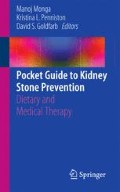Abstract
Common risk factors for the formation of uric acid kidney stones include low urine volume, uricosuria, and low urinary pH of which low urinary pH is the most important risk factor. The primary treatment for uric acid stones involves alkalinizing the urine which alters the solubility of uric acid and its tendency to precipitate in an overly acidic environment. Nutrition intervention plays a secondary role in the management of stone disease; no studies have been conducted comparing pharmacotherapy to nutrition interventions. Dietary factors known to increase serum uric acid and the risk of gout, and evidence from epidemiological trials and studies utilizing stone registries have been used to support dietary measures. Limitations in the literature include: few well-controlled, randomized trials; studies of short duration; normal volunteers recruited instead of stone formers; dietary manipulations focused on multiple instead of single components such as protein; and outcome measurements assessing reduction in risk factors not actual stone formation or recurrence. Gender and age differences may affect stone risk as well. This chapter will examine the well-known factors contributing to stone formation as well as emerging epidemiological trends that may have implications for uric acid nephrolithiasis.
Access this chapter
Tax calculation will be finalised at checkout
Purchases are for personal use only
References
Best SL. Protein restriction and stone disease: myth or reality? In: Pearle MS, Nakada SY, editors. Practical controversies in medical management of stone disease. New York: Springer Science+Business Media; 2014. p. 71–90.
Tracy CF, Best S, Bagrodia A, Poindexter JR, Adams-Huet B, Sakhaee K, Maalouf N, Pak CYC, Pearle MS. Animal protein and the risk of kidney stones: a comparative metabolic study of animal protein sources. J Urol. 2014;192:137–41.
Choi HK, Atkinson K, Karlson EW, Willett W, Curhan G. Purine-rich foods, dairy and protein intake, and the risk of gout in men. N Engl J Med. 2004;350:1093–103.
Zgaga L, Theodoratou E, Kyle J, Farrington SM, Agakov F, Tenesa A, Walker M, McNeill G, Wright AF, Rudan I, Dunlop MG, Campbell H. The association of dietary intake of purine-rich vegetables, sugar-sweetened beverages and dairy with plasma urate, in a cross-sectional study. PLoS One. 2012;7(6):e38123.
Yamamoto T, Moriwaki Y, Takahashi S. Effect of ethanol on metabolism of purine bases (hypoxanthine, xanthine, and uric acid). Clin Chim Acta. 2005;356:35–57.
Choi HK, Curhan G. Beer, liquor, and wine consumption and uric acid level: the third national health and nutrition examination survey. Arthritis Rheum. 2004;51:1023–9.
Adeva MM, Souto G. Diet-induced metabolic acidosis. Clin Nutr. 2011;30:416–21.
Remer T, Manz F. Potential renal acid load of foods and its influence on urine pH. J Am Diet Assoc. 1995;95:791–7.
Frassetto LA, Todd KM, Morris Jr RC, Sebastian A. Estimation of net endogenous noncarbonic acid production in humans from diet potassium and protein contents. Am J Clin Nutr. 1998;68:576–83.
Taylor EN, Curhan GC. Fructose consumption and the risk of kidney stones. Kidney Int. 2008;73:207–2012.
Johnson RJ, Nakagawa T, Sanchez-Lozada LG, Shafiu M, Sundaram S, Le M, Ishimoto T, Sautin YY, Lanaspa MA. Sugar, uric acid, and the etiology of diabetes and obesity. Diabetes. 2013;62:3307–15.
Maalouf NM. Metabolic syndrome and the genesis of uric acid stones. J Ren Nutr. 2011;21:128–31.
Author information
Authors and Affiliations
Corresponding author
Editor information
Editors and Affiliations
Rights and permissions
Copyright information
© 2015 Springer International Publishing Switzerland
About this chapter
Cite this chapter
Davis, L.A. (2015). Nutrition Management of Uric Acid Stones. In: Monga, M., Penniston, K., Goldfarb, D. (eds) Pocket Guide to Kidney Stone Prevention. Springer, Cham. https://doi.org/10.1007/978-3-319-11098-1_9
Download citation
DOI: https://doi.org/10.1007/978-3-319-11098-1_9
Published:
Publisher Name: Springer, Cham
Print ISBN: 978-3-319-11097-4
Online ISBN: 978-3-319-11098-1
eBook Packages: MedicineMedicine (R0)

